A defibrillator, also known as an AED (automated external defibrillator), is a life-saving device that is used to restart a person’s heart in the event of a sudden cardiac arrest. These devices are becoming increasingly common in public spaces, such as airports, malls, and sports venues, as well as in workplaces and homes. In this article, we will take a look at the 10 best defibrillators currently available on the market.
1) Philips HeartStart Home Defibrillator
This defibrillator is designed for use in the home and is easy to use, even for those with no medical training. It features clear, spoken instructions and a simple, two-button design.

Features:-
- Easy-to-use design with clear voice prompts
- Built-in SMART Pads Cartridge that automatically self-tests the defibrillator’s battery and electrodes
- Contains a built-in CPR coaching tool that gives immediate feedback on the rate and depth of compressions.
- Meets the requirements of IP55 for water and dust protection.
- Weights 3.3 pounds and dimensions of 10.4 x 8.3 x 3.5 inches
- Clear, concise, and easy-to-follow visual instructions
- Low-energy training mode that allows you to practice using the AED without delivering a shock
- Include a CPR device as well that offers immediate input on compression rate and depth
- Built-in metronome that helps to guide the rescuer in performing CPR at the correct rate.
2) Zoll AED Plus
This is one of the popular choices for Defibrillators for public spaces, such as airports and malls. It features real-time CPR feedback, making it easy for rescuers to provide effective CPR.
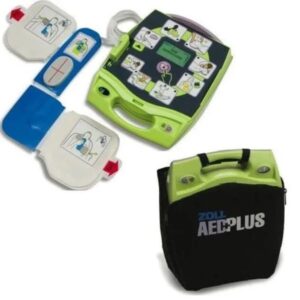
Features:-
- Designed for use in public and professional settings
- Color display that shows real-time information such as ECG and compression depth
- Provides vocal cues to lead customers through the shock delivery process.
- Built-in metronome feature that provides audible prompts to guide compressions
- Weights 5.5 pounds and dimensions of 10.2 x 8.2 x 3.5 inches
- RescueCoach feature that guides users through the entire rescue process, including CPR and defibrillation
- Unique See-Thru CPR feature that allows rescuers to see the patient’s underlying cardiac rhythm, even during CPR compressions
- Long-lasting battery with a maximum 350 shocks or 12 hours of continuous use
- 4-year warranty on the battery and a 5-year warranty on the gadget
- Has an IP55 rating, making it dust and water-resistant.
3) Medtronic Physio-Control Lifepak CR Plus
This defibrillator is designed for use in an emergency medical setting, such as an ambulance or emergency room. It features a color display, voice prompts, and a variety of advanced features, such as ECG monitoring.

Features:-
- Designed for use in professional settings
- Built-in metronome feature that provides audible prompts to guide compressions
- Weights 7.1 pounds and dimensions of 10.5 x 8.5 x 4.5 inches
- Unique See-Thru CPR feature that allows rescuers to see the patient’s underlying cardiac rhythm, even during CPR compressions
- Manual override feature that allows trained users to adjust the energy level delivered
- Long-life battery that can provide up to 350 shocks or 12 hours of continuous operation
- Real-time data recording feature, allowing the device to store and record the information of the rescue event.
- CPR metronome feature that guides the rescuer to perform CPR at the correct rate.
- It is equipped with a manual override feature that allows the user to adjust the energy level delivered to the patient.
- Robust and durable design, making it suitable for use in extreme conditions.
4) Defibtech Lifeline AUTO
This defibrillator is designed for use in public spaces, such as airports and malls. It features a color display, voice prompts, and automated self-tests to ensure that it is always ready for use.
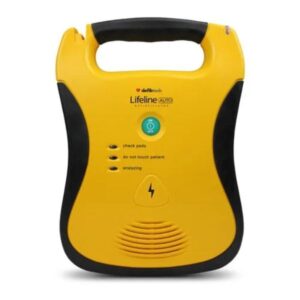
Features:-
- Clear and easy-to-use interface
- Built-in metronome feature that provides audible prompts to guide compressions
- Weights 2.6 pounds and dimensions of 8.5 x 7 x 3 inches
- Long-life battery that can provide up to 400 shocks or 4 hours of continuous operation
- CPR Rate Advisor feature that provides real-time feedback on the rate and depth of compressions
- Unique Pediatric-Pak option that allows for the use of pediatric pads and a reduced energy level for children under 55 pounds
- Unique Rescue Ready feature that verifies the device is functioning properly before each use
- Unique Durable and Rugged design, making it suitable for use in extreme conditions.
5) HeartSine Samaritan PAD 360P
This defibrillator is designed for use in public spaces, such as airports and malls. It features a color display, voice prompts, and automated self-tests to ensure that it is always ready for use.

Features:-
- Lightweight and portable design, weighing only 2.4 pounds
- Built-in metronome feature that provides audible prompts to guide compressions
- Weight of 2.4 pounds and dimensions of 7.5 x 5.5 x 2.5 inches
- Long-life battery that can provide up to 300 shocks or 4 hours of continuous operation
- 8-year warranty on the device and 4-year warranty on the battery
- An IP56 rating, making it dust and water resistant.
- CPR metronome feature which guides the rescuer to perform CPR at the correct rate.
- Real-time data recording feature, allowing the device to store and record the information of the rescue event.
Also Read – 20 Best ECG Machines in 2023
6) Cardiac Science Powerheart G5
This defibrillator is designed for use in a professional setting, such as a hospital or workplace. It features a color display, voice prompts, and automated self-tests to ensure that it is always ready for use.
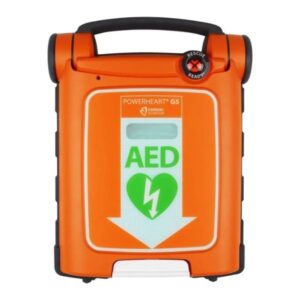
Features:-
- ICPR technology provides real-time, guideline-driven CPR feedback on the quality of chest compressions.
- RescueCoach prompts advance upon completion of each rescue task.
- Dual-language function enables users to toggle between preset primary and secondary languages with a touch of a button.
- The fully automatic G5 unit will deliver a shock automatically when it detects a shockable heart rhythm.
- AED stores 90 minutes of rescue data, accessible by USB cable or USB memory stick.
- IP (ingress protection) rating of IP55 for dust and water.
- Rugged design withstands conditions like extreme temperature, high altitudes, and vibration.
- Non-polarized Intellisense defibrillation pads offer a 2-year shelf life.
- Intellisense Lithium battery offers a 4-year shelf life
- Pediatric capability with Intellisense pediatric defibrillation pads (recommended for patients 8 years of age or younger or weighing less than 55 pounds
- Rescue Ready indicator shows readiness status of battery, pads, and device
- Soft carry case for easy travel
7) Welch Allyn AED 10
This defibrillator is designed for use in a professional setting, such as a hospital or workplace. It features a color display, voice prompts, and automated self-tests to ensure that it is always ready for use.

Features:-
- Two-button operation
- Text and voice instructions guide the user through the rescue.
- Color-coded pads and illustrations ensure proper pad placement.
- Escalating energy (200 J, 300 J, 360 J); energy protocol can be changed to meet specific needs.
- Weight of 3.75 pounds and dimensions of 8.25 x 6.88 x 2.75 inches
- High-performance battery delivers up to five years of standby performance or over 90 discharges at 360 joules.
- Internal memory stores event data including ECG waveforms, time/date stamps, shock delivery and system actions.
- Lightweight and compact—ideal for small spaces.
- Compatible with major manufacturer defibrillator pads.
8) Schiller FRED PA-1
This defibrillator is designed for use in public and professional settings. It has a color display that shows real-time CPR feedback, and it also provides voice prompts to guide users through the process of delivering a shock.
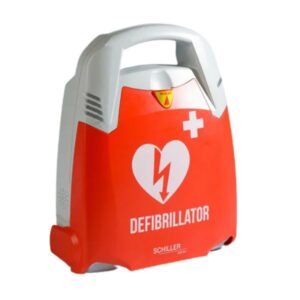
Features:-
- Pre-connected adult electrode pads save vital time during rescue
- 3 simple illustrations and clear voice commands guide the rescuer step by step during the rescue
- 6 year battery life.
- Extra storage slot in the back of the unit for spare electrode pads
- Fully-automatic meaning the AED will automatically deliver a shock after a countdown if required
- Repeat button
- Integrated carry handle makes transportation easy
- Automatic self tests ensure the unit is ready for rescue (a single green LED light on the side of the unit indicates the unit is ready for use)
- Automatic self-tests for detection of electrode expiration and battery capacity are performed weekly. LED lights and audible signals alert if maintenance is required (i.e. new pads, replacement of battery or if the unit requires maintenance)
- CPR Assistant: metronome and Free CPR – feedback on the frequency of chest compression using impedance variation acquired via the defibrillation pads.
9) Nihon Kohden AED-2100
This defibrillator is designed for use in public and professional settings. It has a color display that shows real-time CPR feedback, and it also provides voice prompts to guide users through the process of delivering a shock.
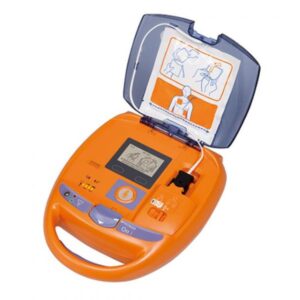
Features:-
- Provides voice prompts to guide users through the process of delivering a shock
- Built-in metronome feature that provides audible prompts to guide compressions
- Weight of 3.8 pounds and dimensions of 8.5 x 6.5 x 3 inches
- Long-life battery that can provide up to 200 shocks or 8 hours of continuous operation
- 8-year warranty on the device and 4-year warranty on the battery
- An IP55 rating, making it dust and water resistant.
- Real-time data recording feature, allowing the device to store and record the information of the rescue event.
- CPR Rate Advisor feature that provides real-time feedback on the rate and depth of compressions
- Pediatric-Pak option that allows for the use of pediatric pads and a reduced energy level for children under 55 pounds
- Rescue Ready feature that verifies the device is functioning properly before each use.
- Data Management feature that allows users to easily download and share rescue data with medical professional
10) Cardiac Science Powerheart AED G3 Pro
The Powerheart AED G3 Pro is designed for the professional rescuer with a color display screen, manual override, and 3-lead ECG monitoring capabilities.With semi-automatic operation, manual override option, and 3-lead ECG monitoring capability, the Powerheart G3 AED Pro gives medical professionals the tools you need to be in complete control.
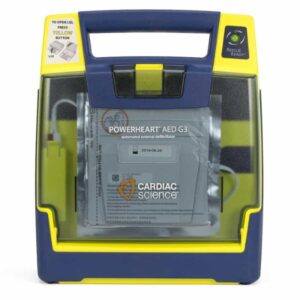
Features:-
- Operations: Semi-automatic with manual override
- Waveform: STAR biphasic truncated exponential
- Energy (J) range available: Escalating variable energy (VE) 95J to 351J
- Protocols: 5 energy protocols available
- Factory default (nominal): 200VE, 300VE, 300VE
- Voice prompts: Clear, concise voice prompts guide user through the rescue
- Visible indicators: Rescue Ready status indicator
- Audible alerts: Voice prompt, system alert
- Synchronized shock: Built-in automatic synchronization feature
- Control buttons: Shock button and manual override
- Display content: Displays written instructions to guide user through rescue process, SmartGauge battery status indicator, service indicator, pad indicator, text display, ECG display
- Display specifications: 3.5 in (8.9 cm) diagonal transflective TFT display with 320 x 240 pixels (quarter VGA). Resolution is 113.5 dots/in (4.47 dots/mm)
Frequently Asked Questions (FAQs)
What is a defibrillator?
A defibrillator is a medical device that is used to restore a normal heartbeat by sending an electric shock to the heart.
How does a defibrillator work?
A defibrillator works by delivering an electrical shock to the heart in order to reset the heart’s electrical system and restore a normal heartbeat.
Who can use a defibrillator?
A defibrillator can be used by trained medical professionals, such as doctors, nurses, and paramedics, as well as by individuals who have received appropriate training in how to use the device.
When should a defibrillator be used?
A defibrillator should be used in the event of sudden cardiac arrest, when the heart stops beating or beats irregularly, and there is a risk of death if normal heart rhythm is not restored quickly.
Are defibrillators safe to use?
Yes, defibrillators are safe to use when operated properly by trained individuals. They are designed to deliver electric shocks in a controlled manner and are equipped with safety features to prevent accidental shocks.
What types of defibrillators are available?
There are two main types of defibrillators: external defibrillators, which are used outside of the body, and internal defibrillators, which are implanted in the chest.
Can defibrillators be used on children?
Yes, some defibrillators have pediatric settings and can be used on children who weigh less than 55 pounds. However, it’s important to follow the manufacturer’s instructions and receive appropriate training before using a defibrillator on a child.
How effective are defibrillators?
Defibrillators are very effective in restoring the normal rhythm of the heart in cases of cardiac arrest. The sooner a defibrillator is used, the greater the chances of survival.
Are defibrillators expensive?
The cost of a defibrillator can vary depending on the type of device and its features.
Can defibrillators save lives?
Yes, defibrillators can be highly effective in restoring a normal heartbeat and saving lives in the event of sudden cardiac arrest. Quick use of a defibrillator, combined with CPR and emergency medical care, can significantly increase a person’s chance of survival.
How do you maintain a defibrillator?
Defibrillators should be regularly checked and maintained according to the manufacturer’s instructions to ensure that they are functioning properly. This may include checking the battery, electrodes, and other components, and conducting regular tests.
Are defibrillators only used in hospitals?
Defibrillators are commonly used in hospitals, but they can also be found in public places such as airports, schools, and sports facilities. Some people may also have defibrillators implanted in their chests to manage certain heart conditions.
What are the risks associated with using a defibrillator?
The risks associated with using a defibrillator are generally low, but they can include burns or other skin irritation from the electrodes, and rare complications related to the delivery of electric shocks.
How long does it take to use a defibrillator?
Using a defibrillator typically takes only a few minutes, depending on the type of device and the user’s level of training. In an emergency situation, it’s important to act quickly and follow the instructions on the device.
Can anyone buy a defibrillator?
Yes, in many countries, defibrillators can be purchased by individuals or organizations for use in emergency situations. However, it’s important to receive proper training and follow local regulations related to the use and maintenance of defibrillators.
References
- https://cpr.heart.org ›
- https://www.news-medical.net/Powerheart-G3-Pro-from-Cardiac-Science
- https://www.philips.co.in/healthcare/solutions/emergency-care-resuscitation/automated-external-defibrillators
- https://www.medisolinternational.com/physio-control-lifepak-cr-plus-fully-automatic-aed.html

Hi, I’m the Founder and Developer of Paramedics World, a blog truly devoted to Paramedics. I am a Medical Lab Tech, a Web Developer and Bibliophiliac. My greatest hobby is to teach and motivate other peoples to do whatever they wanna do in life.